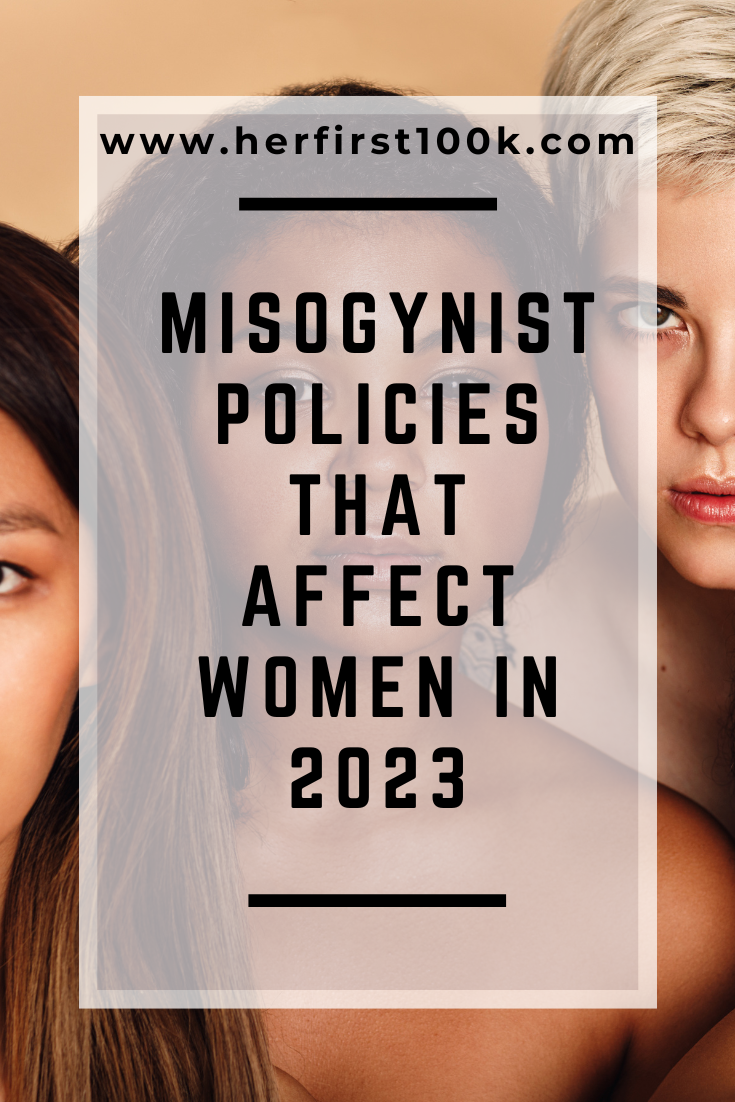The following article may contain affiliate links or sponsored content. This doesn’t cost you anything, and shopping or using our affiliate partners is a way to support our mission. We will never work with a brand or showcase a product that we don’t personally use or believe in.
Misogynistic Policies That Affect Women in 2023
Every time Women’s History Month rolls around, we can’t help but reflect on all that women achieved in the last year.
The percentage of female Fortune 500 CEOs hit an all-time high at 10%.
Beyoncé won her 32nd Grammy, giving her the most Grammy wins of all time.
We saw a money book built on the principles of financial feminism hit The New York Times bestseller list. *Insert shameless plug for Financial Feminist here.*
We also saw deeper struggle. We watched American women fight for the right to make choices about their own bodies and Iranian women courageously lead protests for their freedom.
When looking at the recent world-shaking accomplishments of women, it can be easy to admire the obvious strength, determination, and hard work required for any one of these achievements. But what is often harder to acknowledge and appreciate is the extra effort required by every woman to reach levels of achievement while facing policies that uniquely affect and disadvantage them.
For all of our progress, women in the US and beyond continue to endure policies that not only do not serve them, but actually harm them and hinder their wellbeing and opportunity.
The first step in creating systemic change is becoming aware of what needs changing, and we can’t think of a better time to bring attention to these outdated, patriarchal policies than during Women’s History Month.
The Gender Wage Gap
If we’ve learned anything from sharing feminist content on the internet, it’s that as soon as we mention the gender wage gap, a swarm of misogynistic keyboard warriors will appear to share that “the gender wage gap is a myth” and “women just choose lower-paying jobs than men.”
*gag*
The reality is that, according to Women, Business and the Law 2021, in 100 economies around the world including the US, laws do not mandate that men and women be paid equally for the same job. So what does this look like in real life?
According to the National Partnership for Women and Families, in 2022 women who work full-time, year-round are paid on average only 82 cents for every dollar paid to men in the same role and industry. This ultimately results in a gap of $10,157 every year.
Mind you, this statistic is for childless white women. The wage gap is even worse for women of color, with many Asian American and Pacific Islander women receiving only 52 cents for every dollar paid to their male counterparts. And if you’re a mother, your pay is likely to additionally decrease despite your work performance.
And while yes, we acknowledge that the gender wage gap has narrowed in recent years, that does not negate the fact that it continues to be a relevant threat and disadvantage to women.
In fact, if the wage gap continues to narrow at the same rate, women won’t achieve equal pay to men until 2059.
So what is being done to address the pay disparity between men and women?
In 2021 The Paycheck Fairness Act was reintroduced after failing to pass in 2012. The PFA addresses wage discrimination on the basis of sex (including pregnancy, sexual orientation, gender identity, and sex characteristics) and would help to close the gaps in wages by eliminating loopholes in the Equal Pay Act. This would ultimately help to end pay discrimination while also providing workplace protections for women.
The Senate failed to pass The Paycheck Fairness Act. This shows the need to work in our own communities and workplaces to address the gender wage gap by having transparent conversations about our earnings and equipping ourselves with salary negotiation tools in order to ensure that we receive the level of pay that we deserve. (Listen to this negotiation podcast episode to learn how to approach salary conversations with confidence.)
Lack of Paid Parental Leave in the US
Remember how we mentioned that women are more likely to see their pay decrease once they have children? Unfortunately, the economic disadvantages to mothers do not stop there.
Despite countless studies proving the mental and physical benefits of newborn bonding time for both children and parents, the US is the only rich country offering no national paid parental leave program. In fact, only 21% of US workers have access to paid family leave through their employers, and Federal law guarantees new parents just six weeks of time off – unpaid time off, mind you, and not all workers qualify.
The effect that this has on the female workforce, especially for new mothers, is significant. Not only does six weeks hardly provide enough time to fully recover from birth, settle into a routine as a new mother, and bond with their child, but with 54% of Americans living paycheck to paycheck, the financial burden of going six weeks without pay can be catastrophic to many households.
With private businesses being largely left to determine parental leave for employees, even women who do receive paid time off through their employer may only receive up to 12 weeks of pay, and often at a far lower rate than their typical salary. Additionally, many businesses are less likely to hire new or expecting mothers in the first place, limiting their professional and economic opportunities.
Despite the evident flaws in employer-provided parental leave and 82% of Americans supporting access to paid parental leave, the same study conducted by the International Journal of Comparative Sociology showed that only 47% support government funding paid parental leave, preferring that employers continue to fund it – which we now know would increase costs for employers and reduce overall employment.
So what does this mean for women?
It means that many women feel obligated to choose between career and family, and risk returning to work before they are physically, mentally, and emotionally ready to do so out of financial need. Additionally, it hurts the female workforce by creating fewer job opportunities for mothers.
Fortunately, the public uproar over the lack of paid parental leave in the US has been increasing, and in November 2021, the House passed the Build Back Better Act which includes 4 weeks of paid leave. Despite this step in the right direction, the US continues to lag behind other countries that have an average of 29 weeks of paid family leave.
Covid’s Impact on Women in the Workforce
As the US and many countries around the world experienced weeks of shutdowns, people endured unprecedented waves of unemployment and financial insecurity.
While the overall workforce struggled during the pandemic, women felt the brunt of that struggle. Already at a disadvantage due to the gender wage gap, the pandemic put additional economic pressures on women as some of the sectors with the highest rates of unemployment were those with a higher share of female employment such as hospitality, food services, and personal care.
According to the International Labour Organization, female employment around the world declined by 4.2% in 2020 compared to the previous year, with the US having the highest decline in female employment at 9.4%.
While access to jobs dramatically decreased during the pandemic, domestic responsibilities increased as children transitioned to at-home learning and childcare became unavailable. This resulted in women having to take up a greater share of domestic chores than men despite their employment status, commonly resulting in exhaustion and burnout. This lack of work/life balance caused many women to drop out of the workforce in order to have the capacity to maintain increasing domestic responsibilities.
Journalist Akrur Barua writes, “This decline in female employment, along with women’s reduced participation in the labor force, is a major setback to efforts over the past two decades at increasing gender equality.”
Even now post-covid-vaccine as many economies are on the road to recovery, women have recovered significantly fewer jobs than men in similar demographics, ultimately reducing women’s presence in the workforce and limiting their professional and economic development.
What Can We Do?
When it comes to creating significant, lasting changes in policy, there are unfortunately no quick fixes.
We can continue to have transparent conversations about our pay and professional experiences and encourage others to do the same. We can seek and/or offer jobs that pay fairly and offer paid family leave. We can invest in resources that teach us how to advocate for ourselves and the women around us. We can support ethical businesses that strive to invest in their female employees.
We can advocate for further feminist financial education to ensure women are equipped with the knowledge they need and deserve.
But much like when individuals were encouraged to switch to paper straws to save the environment while corporations continued to dump oil into the oceans, doing our part to change policies that are holding women back comes down to holding the people in power accountable.
I get asked all the time: “where do I start?!”
Take my free money personality quiz for step-by-step guidance and actionable resources to meet you at each stage of your financial journey.



